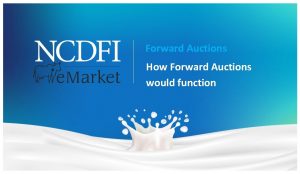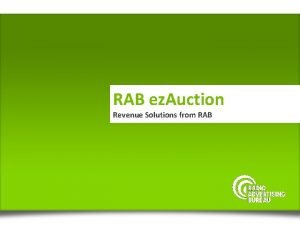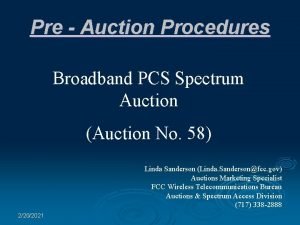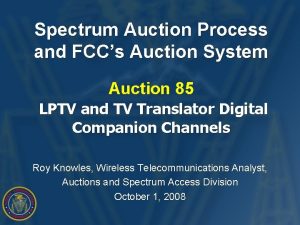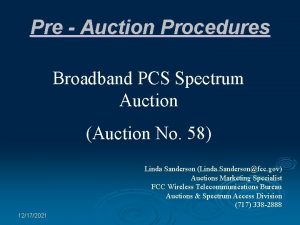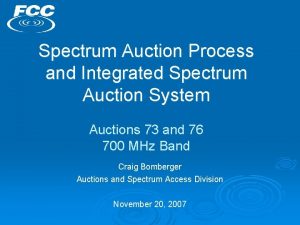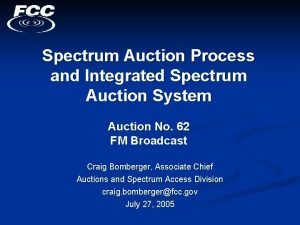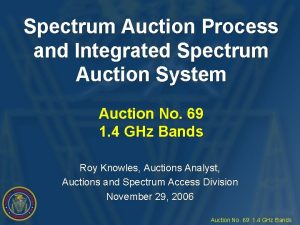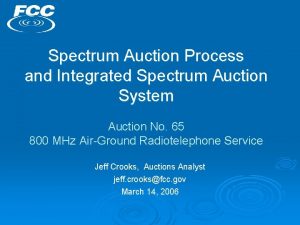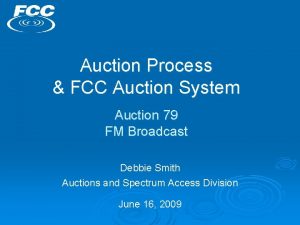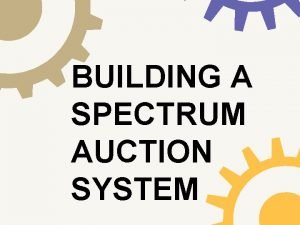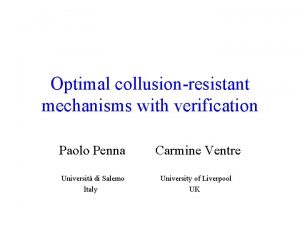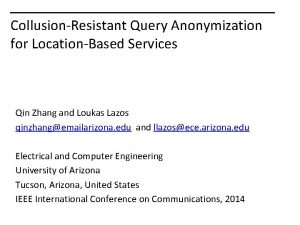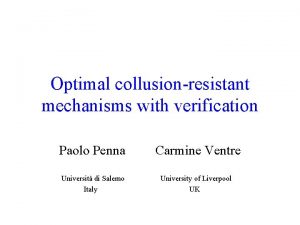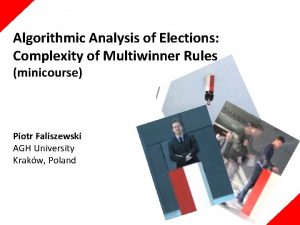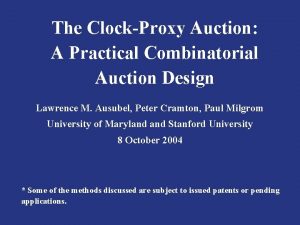A MultiWinner Cognitive Spectrum Auction Framework with CollusionResistant



![Related Work l l l In [7], the price of anarchy was analyzed for Related Work l l l In [7], the price of anarchy was analyzed for](https://slidetodoc.com/presentation_image_h/1924bc83fc2cc599e83cff7cd9d66fbe/image-4.jpg)






















![Reference l [7] M. M. Halldorson, J. Y. Halpern, L. Li, and V. S Reference l [7] M. M. Halldorson, J. Y. Halpern, L. Li, and V. S](https://slidetodoc.com/presentation_image_h/1924bc83fc2cc599e83cff7cd9d66fbe/image-27.jpg)
- Slides: 27

A Multi-Winner Cognitive Spectrum Auction Framework with Collusion-Resistant Mechanisms Yongle Wu, Beibei Wang, K. J. Ray Liu, University of Maryland T. Charles Clancy US Department of Defense Dynamic SPectrum Access Networks, Dy. SPAN 2008 1

Outline l l l l Introduction Related Work System Model The Vickery-Clarke-Groves (VCG) Mechanism Proposed Mechanism Results Conclusions 2

Introduction l Dynamic spectrum access allows the unlicensed users to dynamically access the licensed bands from primary users in either a noncooperative fashion or a cooperative fashion l Non-cooperative l l Cooperative l l primary users do not need to consider the existence of secondary users spectrum opportunities can be announced by primary users rather than detected by secondary users The cooperative approach can be implemented on a pricing basis l Primary users would like to trade their temporarily unused bands for monetary gains l Secondary users also want to lease some channels to transmit their information as long as the communication gains exceed the cost 3
![Related Work l l l In 7 the price of anarchy was analyzed for Related Work l l l In [7], the price of anarchy was analyzed for](https://slidetodoc.com/presentation_image_h/1924bc83fc2cc599e83cff7cd9d66fbe/image-4.jpg)
Related Work l l l In [7], the price of anarchy was analyzed for spectrum sharing in Wi. Fi networks In [8], a demand responsive pricing framework was proposed to maximize the profits of legacy spectrum operators while considering the buyers’ response model In [9], an auction-based mechanism was proposed to efficiently share spectrum among secondary users in interference-limited systems In [10], the authors considered a multi-unit sealed-bid auction for efficient spectrum allocation In [11], a real-time spectrum auction framework with interference constraints was proposed to get a conflict-free allocation In [12], a belief-assisted distributive pricing algorithm was proposed to achieve efficient dynamic spectrum allocation based on double auction mechanisms 4

Difference from Previous Work l Some critical challenges still remain unanswered l In most of the current auctions, one licensed band is awarded to a unique buyer l the spectrum resource is interference-limited rather than quantitylimited l Although a few papers discuss spectrum auctions under interference constraints, all of them are based on the assumption that secondary users will bid their true valuations l secondary users may be selfish and only aim to maximize their own interests l the Vickery-Clarke-Groves (VCG) mechanism ensures that truthtelling is a dominant bidding strategy for individual buyers, but is quite vulnerable to collusion attacks 5

System Model (1) l Consider a cognitive radio network where N secondary users coexist with M primary users l l We model it as an auction where the sellers are the primary users, the buyers are the secondary users and the auctioneer is a spectrum broker For simplicity, we assume each primary user owns one band exclusively, and each secondary user needs only one band First consider the auction with a single band (M =1), and later extend it to the multi-band auction If a primary user decides not to use his own licensed band, he will notify the spectrum broker the intention to sell the spectrum rights 6

System Model (2) l l The potential buyers submit their sealed bids b =[b 1, b 2, . . . , b. N] to the spectrum broker l bi is the bid made by user i The broker decides l the allocation x =[x 1, x 2, . . . , x. N] l l xi =1 means secondary user i wins some band the prices p =[p 1, p 2, . . . , p. N] l pi is the price for secondary user i l Winner Set: W ⊆{1, 2, . . . , N} l i ∈ W if and only if xi =1 l Assume user i gains vi from transmitting information in the leased band, his reward is 7

System Model (3) l Given all users’ valuations v= [v 1, v 2, . . . , v. N], the system utility, or the social welfare, can be represented by l l An auction is efficient if its outcome maximizes the social welfare Interference constraints l Cij =1 if user i and user j cannot be assigned the same band 8

Selfish Secondary Users l The secondary users want to successfully lease the band with the lowest possible price, it is reasonable to assume that all the secondary users are selfish l a secondary user may cheat by misrepresenting his/her valuation l a clique of the secondary users may plot collusion before participating in the auction l There are mainly two emerging kinds of collusion l loser collusion l l several losers, by raising their bid collusively, may overtake the winners and get the spectrum lease instead sublease collusion l several winners sublease the spectrum to others and effortlessly take away some profits that are supposed to be credited to the primary user 9

The VCG Mechanism l Characteristics of the VCG mechanism l ensure full system efficiency l enforce truth-telling l bi = vi will be adopted by all secondary users as the best bidding strategy l An auction mechanism defines rules for two consecutive steps: l the rule to determine winners l the rule to determine prices l Under the VCG mechanism l the winners are decided in such a way that the social welfare is maximized l the price charged to each winner equals his “social opportunity cost” to the whole system 10

Winner Decision l l l For a cognitive spectrum auction, only the secondary users without mutual interference can be awarded the band simultaneously l we call it a compatible combination Throughout all compatible combinations, the one with the highest social welfare will become the set of winners For simplicity, denote l x∗: the maximizer to this problem l Uv∗ = Uv(x∗): the maximum system utility attained l v−i =[v 1, v 2, . . . , vi− 1, vi+1, . . . , v. N]: the set similar to v except that the i-th entry is excluded 11

Price Decision l Social Opportunity Cost l If user i were absent and everyone else remained in the system, the social welfare would be Uv−i∗ l the total utility of all users except i is Uv∗ −vi l Uv−i∗− (Uv∗ − vi) is the “damage” that user i causes to the whole society l VCG pricing requires the winners to make compensation by paying l Case (a) l x∗ = [0, 1, 1, 1] l Uv∗ = v 2 + v 3 + v 4 = 20 l For user 2 l l Uv− 2∗ = v 1 =15 p 2 = v 2 + Uv− 2∗ − Uv∗ = 1 12

Drawbacks of the VCG Mechanism (1) l l l The total payment collected by the primary user is quite low compared to the system utility l Case (a): p 2 + p 3 + p 4 = 6 There is no guarantee that the primary user’s revenue is bounded away from zero l if v 1 = v 2 = v 3 = v 4 = 10, the primary user sells the spectrum for nothing Second, the losers may take advantage of the VCG pricing by colluding l losers in Case (b) may collude to claim the same valuations as in Case (a), whose outcome is favorable since all colluders gain positive rewards l r 2 = v 2 − p 2 = 1, r 3 = 1, and r 4 = 2, 13

Drawbacks of the VCG Mechanism (2) l Colluders may extract some profits from the seller by sublease collusion l In case (c), user 3 and user 4 may now collude with user 5 by subleasing the band at price p 5 = 7, and the income is split between them as 6 and 1 l l l both user 3 and 4 make extra profit user 5 also benefits from subleasing since the reward is v 5−p 5 = 1 Low revenue and vulnerability to collusion attacks make the VCG mechanism unsuitable for the multi-winner auction 14

The Second-Price Auction l Auction rule l the bidder with the highest bid wins the item, and pays the amount of money equal to the second highest bid l It is well-known that submitting bids equal to their true valuations is the dominant strategy l by submitting a higher bid than true valuation, the buyer may end up with paying more money than what it actually worth l by submitting a lower bid, the buyer may lose the opportunity to win the item l Moreover, the primary user’s revenue in the second-price auction will not be too low, since the price equals the second highest bid 15

Proposed Mechanism for the Multi-winner Auction (1) l Basic Auction Mechanism l l l In order to apply the second-price idea, we have to remodel the multiwinner spectrum auction into a single-winner auction by introducing the concept of virtual bidders l l l keep the same winner determination method as the VCG mechanism employ second-price strategies to avoid the drawbacks of VCG mechanism group secondary users with negligible interference together as virtual bidders the valuation of the virtual bidders equal the sum of the individual valuations The virtual bidder with the highest bid will be awarded the band, and the total payment equals the highest bid made by the virtual bidder after the winners are removed from the system 16

Proposed Mechanism for the Multi-winner Auction (2) l l l The only unsolved problem is splitting the payment among the secondary users within the winning virtual bidder The spectrum broker sets the prices for each winner such that the profits are shared among the winners as equally as possible When such a pricing strategy is used l l l the seller’s revenue is Uv−W∗, which is often relatively high if some losers collude to beat the winners by raising their bids, they will have to pay more than Uv−W∗ 17 the sublease collusion can be also alleviated to some extent

Sublease Collusion l l Given any colluding-winner subset WC ⊆ W, the possible colluding losers must come from a subset of the losers whose members are interference-free with those users in W−WC, denoted by L(W−WC) If the prices are set such that l there will be no sublease collusion l l The optimum collusion-resistant pricing strategy is the solution to the following problem 18

Interference Matrix l l Since interference matrix C comes from secondary users’ own reports, it is quite possible that the selfish users manipulate this information Secondary users have no incentive to cheat l if Cjk = 0, but user j claims Cjk =1, user j may lose an opportunity of being a winner l l l Cjk = 0, no interference if Cjk = 1 but user j claims Cjk =0, the band cannot be used at all due to strong interference A group of secondary users are able to distort the information collusively l assume user sets {1, 2, 3} and {1, 2, 4} are compatible combinations, and {1, 2, 3} is the winner set l if user 1 and 4 belong to the same group of interest, user 1 will claim C 13 = 1 to kick user 3 out and make {1, 2, 4} the winner set instead l Solution: the spectrum broker only sets Cjk to 1 when both user j and k 19 declare they have mutual interference

Multi-Band Extension l There are M bands (M> 1) available for the secondary users l l assume each secondary user could lease at most one band The allocation strategy can be similarly determined by the following BIP problem 20

Greedy Algorithm for Multi-Band Problem l l l The greedy algorithm simply allocates the band one by one Denote l L(m): the set of potential buyers in the m-th iteration l initially, L(1) = {1, 2, . . . , N} l W(m): the set of winners awarded with band m W(m) can be solved from l After each iteration, L(m+1) = L(m) − W(m) is updated 21

Simulation Environment l l Consider a 1000× 1000 m 2 area, in which N secondary users are uniformly distributed Assume each secondary user is a cognitive base station with RI –meter coverage radius l l two users at least 2 RI meters away can share the same band without mutual interference The valuations of different users {v 1, v 2, . . . , v. N} are assumed to be i. i. d. random variables uniformly distributed in [20, 30] 22

Seller’s Revenue versus the Number of Secondary Users 23

Normalized Collusion Gains 24

Efficiency of the Greedy Algorithm 25

Conclusions l Propose a multi-winner auction framework for the spectrum auction in cognitive radio networks l Propose new auction mechanisms l l guarantee full efficiency of the spectrum utilization yield higher revenue to primary users help eliminate user collusion Extend the one-band auction mechanism to the multi-band case, and propose a greedy algorithm that can achieve almost the same efficiency as the optimal solution 26
![Reference l 7 M M Halldorson J Y Halpern L Li and V S Reference l [7] M. M. Halldorson, J. Y. Halpern, L. Li, and V. S](https://slidetodoc.com/presentation_image_h/1924bc83fc2cc599e83cff7cd9d66fbe/image-27.jpg)
Reference l [7] M. M. Halldorson, J. Y. Halpern, L. Li, and V. S Mirrokni, “On spectrum sharing games, ” Proc. ACM on Principles of distributed computing, pp. 107– 114, 2004. l [8] O. Ileri, D. Samardzija, and N. B. Mandayam, “Demand responsive pricing and competitive spectrum allocation via a spectrum server, ” IEEE Symposium on New Frontiers in Dynamic Spectrum Access Networks (Dy. SPAN’ 05), pp. 194– 202, Baltimore, Nov. 2005. l [9] J. Huang, R. Berry, and M. L. Honig, “Auction-based spectrum sharing, ” ACM/Springer Mobile Networks and Apps. , , vol. 11, no. 3, pp. 405– 418, June 2006. l [10] C. Kloeck, H. Jaekel, and F. K. Jondral, “Dynamic and local combined pricing, allocation and billing system with cognitive radios, ” IEEE Symposium on New Frontiers in Dynamic Spectrum Access Networks (Dy. SPAN’ 05), pp. 73– 81, Baltimore, Nov. 2005. l [11] S. Gandhi, C. Buragohain, L. Cao, H. Zheng, and S. Suri, “A general framework for wireless spectrum auctions, ” IEEE Symposium on New Frontiers in Dynamic Spectrum Access Networks (Dy. SPAN’ 07), pp. 22– 33, Dublin, Apr. 2007. l [12] Z. Ji, and K. J. R. Liu, “Belief-assisted pricing for dynamic spectrum allocation in wireless networks with selfish users, ” in Proc. IEEE Int’l Conference on Sensor, Mesh, and Ad Hoc Communications and Networks (SECON), pp. 119– 127, Reston, Sep. 2006 27
 Absorption spectrum
Absorption spectrum Copper subshell configuration
Copper subshell configuration Cognitive and non cognitive religious language
Cognitive and non cognitive religious language Auction in monopoly
Auction in monopoly Reverse auction process flow
Reverse auction process flow Car auction games
Car auction games Loa lpp lwl
Loa lpp lwl Metaljunction auction
Metaljunction auction Auction system project in java
Auction system project in java Zango auction results
Zango auction results Broadcast auction
Broadcast auction Bgs auction
Bgs auction Silent auction event check-in
Silent auction event check-in Auction sourcing tool
Auction sourcing tool Rggi auction results
Rggi auction results Penny test software
Penny test software Selling on e bay
Selling on e bay Glc master acct
Glc master acct Values auction exercise
Values auction exercise Nj bgs auction
Nj bgs auction The slave auction theme
The slave auction theme Descending clock auction
Descending clock auction Auction class diagram
Auction class diagram![Ice] inkan auction Ice] inkan auction](data:image/svg+xml,%3Csvg%20xmlns=%22http://www.w3.org/2000/svg%22%20viewBox=%220%200%20200%20200%22%3E%3C/svg%3E) Ice] inkan auction
Ice] inkan auction Forward auctions
Forward auctions Ez auction
Ez auction Kdlm radio auction
Kdlm radio auction Theoretical framework
Theoretical framework



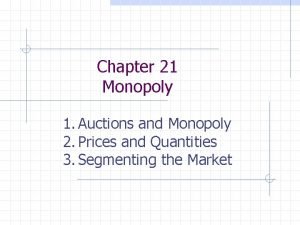

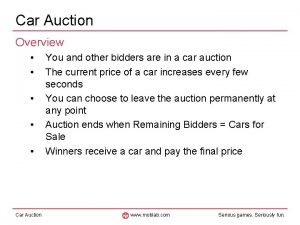



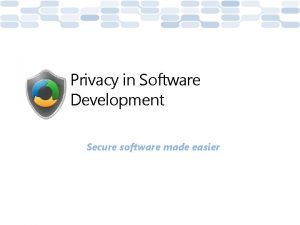
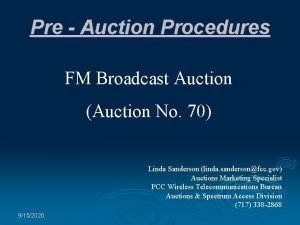


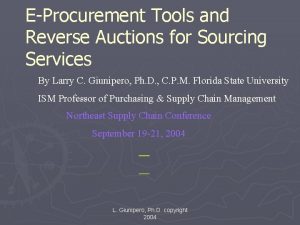





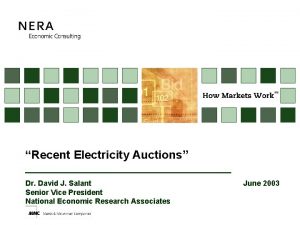
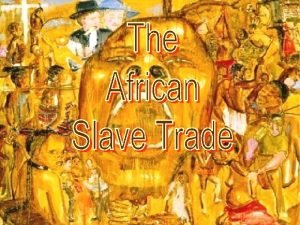
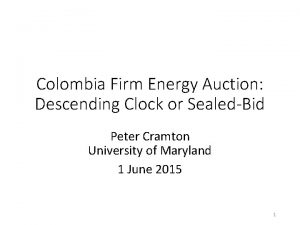
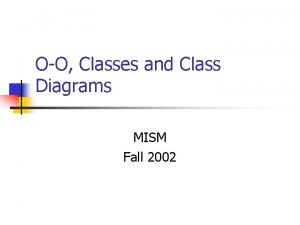
![Ice] inkan auction Ice] inkan auction](https://slidetodoc.com/wp-content/uploads/2021/03/4265618_1c2d54474a1aa46eca42079887e1f0d3-300x225.jpg)
